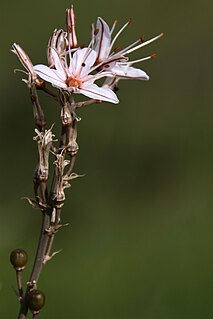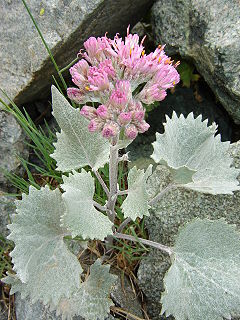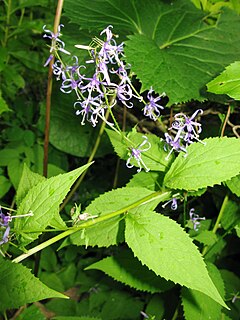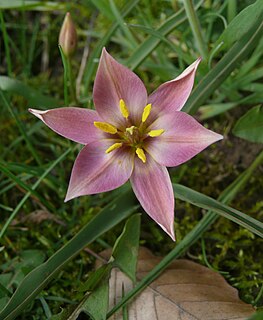
Asphodelus ramosus, also known as branched asphodel, is a perennial herb in the Asparagales order. Similar in appearance to Asphodelus albus and particularly Asphodelus cerasiferus and Asphodelus aestivus, it may be distinguished by its highly branched stem and smaller fruits. There has been a lot of confusion over the nomenclature and taxonomy of the species, owing to its similarity to Asphodelus aestivus.

Adenostyles is a genus of flowering plants in the sunflower family Asteraceae, and of the tribe Senecioneae. It was described as a genus in 1816. Adenostyles occur in the temperate climates of the northern hemisphere, mainly in Europe and Asia Minor.

Ajuga, also known as bugleweed, ground pine, carpet bugle, or just bugle, is a genus of 40 species annual and perennial herbaceous flowering plants in the Ajugeae tribe of the mint family Lamiaceae, with most species native to Europe, Asia, and Africa, but also two species in southeastern Australia. They grow to 5–50 cm tall, with opposite leaves.

Gagea is a large genus of spring flowers in the lily family. It is found primarily in Eurasia with a few species extending into North Africa and North America.

Ballota (horehound) is a genus of flowering evergreen perennial plants and subshrubs in the family Lamiaceae. native to temperate regions. The Mediterranean region has the highest diversity in the genus, with more isolated locations in South Africa, Central Asia, northern Europe, and the islands of the eastern North Atlantic. It is found in rocky and waste ground.

Moluccella is a genus of annual and short-lived perennial plants native to Central + southwestern Asia and the Mediterranean. They are tall, upright, branched plants to 1 meter or more with toothed leaves and small white fragrant flowers.
- Moluccella aucheri(Boiss.) Scheen - Iran, Pakistan
- Moluccella bucharica(B.Fedtsch.) Ryding - Tajikistan
- Moluccella fedtschenkoana(Kudr.) Ryding - Tajikistan
- Moluccella laevisL. - Bells of Ireland - Turkmenistan, Iran, Iraq, Caucasus, Cyprus, Syria, Lebanon, Palestine, Turkey; naturalized in scattered locations in Europe, Africa, and North America
- Moluccella olgae(Regel) Ryding - Tajikistan, Kyrgyzstan
- Moluccella otostegioidesPrain - Pakistan
- Moluccella sogdiana(Kudr.) Ryding - Tajikistan
- Moluccella spinosaL. - Mediterranean from Spain + Algeria to Turkey + Palestine

Teucrium chamaedrys, the wall germander, is a species of ornamental plant native to Mediterranean region of Europe and North Africa, and to the Middle East as far east as Iran. It was historically used as a medicinal herb for the treatment of gout and sometimes as a component of Venice treacle.

Pancratium maritimum, or sea daffodil, is a species of bulbous plant native to the Canary Islands and both sides of the Mediterranean region and Black Sea from Portugal, Morocco and the Balearic Islands east to Turkey, Syria, Israel and the Caucasus. In the parts of its range on the south Bulgarian and north Turkish and Georgian coasts of Black Sea, it is threatened with extinction. It is also naturalized in southern California, Bermuda and the Azores.

Chaerophyllum is a genus of flowering plant in the family Apiaceae, with 35 species native to Europe, Asia, North America, and northern Africa. It includes the cultivated root vegetable Chaerophyllum bulbosum.

Sternbergia is a genus of Eurasian and North African plants in the Amaryllis family, subfamily Amaryllidoideae.

Eremurus is a genus of deciduous perennial flowers, also known as the foxtail lilies or desert candles. They are native to eastern Europe and temperate Asia from Turkey + Siberia to China.
Ammochloa is a genus of Mediterranean plants in the grass family, Poaceae.

Ventenata is a genus of plants in the grass family, native to Europe, North Africa, and central + southwest Asia. One species, Ventenata dubia, is considered an invasive weed in many places.

Asphodeline lutea is a perennial plant native to southeastern Europe, northern Africa, the Caucasus and the Levant. It is grown as a landscaping plant.

Hyacinthella is a genus of bulbous flowering plants in the family Asparagaceae, subfamily Scilloideae. It is native to eastern and south-eastern Europe through to northern Iran, reaching as far south as Palestine. Turkey is the main country in which species are found.

Asyneuma is a genus of flowering plants in the bellflower family, Campanulaceae. They are native to North Africa and Eurasia. Many are endemic to Turkey. Plants of the genus may be known commonly as harebells, but this name can also apply to the entire family. There are up to about 33 species.

Tulipa humilis is a species of flowering plant in the lily family, found in Syria, Lebanon, Israel, Turkey, Iran, and the North Caucasus region of Russia. The flowers are pink with yellow centers. Its preferred habitat are rocky mountain slopes. It is known by several other names in horticulture.

Tulipa agenensis is a Middle Eastern species of flowering plants in the family Liliaceae. It is native to Turkey, Iran, Cyprus, the Aegean Islands, Syria, Lebanon, Israel, Jordan, and Palestine, and naturalized in the central and western Mediterranean.

The taxonomy of Tulipa places the genus in the family Liliaceae, and subdivides it as four subgenera, and comprises about 75 species.


















